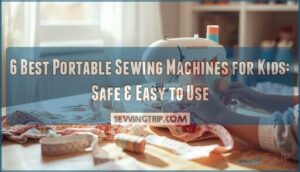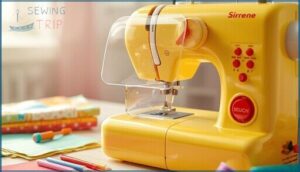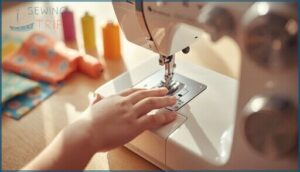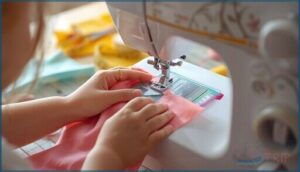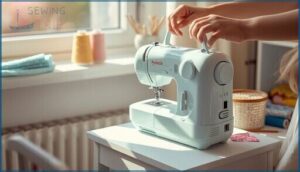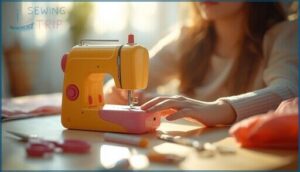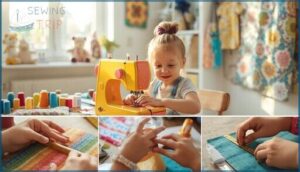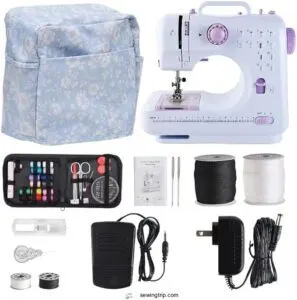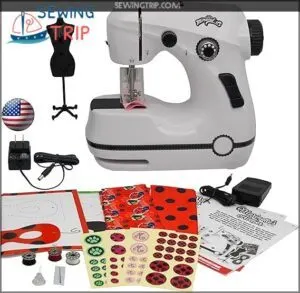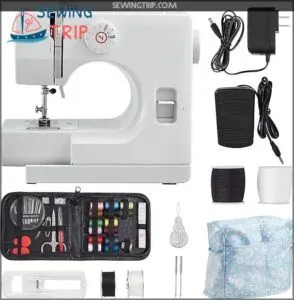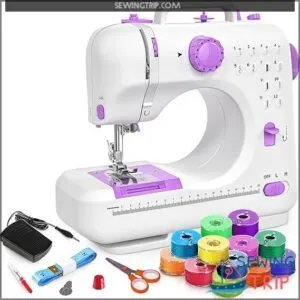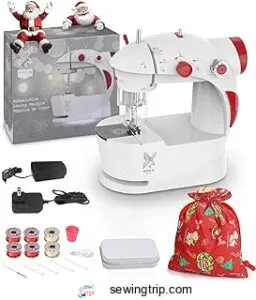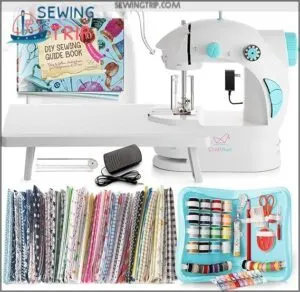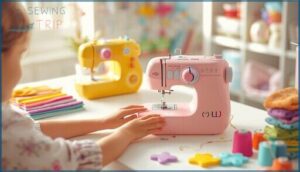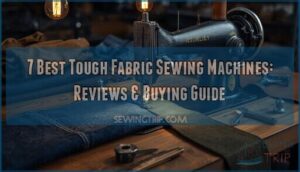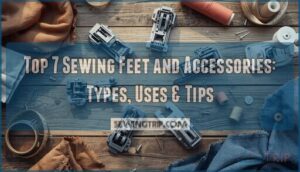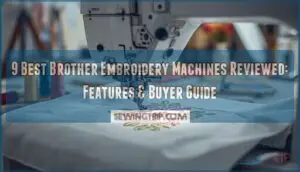This site is supported by our readers. We may earn a commission, at no cost to you, if you purchase through links.
Your child watches you mend a torn backpack and asks, “Can I try?” That spark of curiosity is worth protecting. Portable sewing machines for kids transform that moment into months of creative play, teaching patience and precision while keeping little fingers safe.
These pint-sized powerhouses aren’t toys—they’re real machines scaled down with safety guards, adjustable speeds, and simple threading systems that won’t frustrate beginners. The best models balance genuine functionality with foolproof design, giving kids the satisfaction of completing actual projects without the hazards of adult equipment.
Finding one that grows with your child’s skills means looking beyond flashy features to focus on durability, ease of use, and the right mix of safety and creative freedom.
Table Of Contents
Key Takeaways
- Look for portable sewing machines with genuine safety features like finger guards, adjustable speed controls, and drop-in bobbins rather than flashy branding—these protect kids while teaching real skills instead of creating toy-like frustration.
- Kids as young as 6-7 can start with supervision, but around age 8 they’re typically ready to thread machines independently and tackle actual fabric projects like tote bags and pillows that build confidence through tangible results.
- The sweet spot for beginners is 8-12 built-in stitches with dual power options (battery and AC) in a machine under 5.5 pounds—enough versatility to grow with your child without overwhelming them or limiting where they can create.
- Sewing transforms into hands-on STEM learning as kids naturally practice fractions through measurements, develop fine motor skills that improve hand-eye coordination by 23%, and build patience through multi-step projects that 92% of educators notice strengthening attention spans.
Key Features of Portable Sewing Machines for Kids
Choosing the right sewing machine for your child means looking beyond flashy colors and kid-friendly branding. The best models balance safety features with functionality, giving young sewers room to learn without overwhelming them.
Here are the key features that make a portable sewing machine truly kid-friendly.
Age-Appropriate Safety Mechanisms
When you’re choosing a machine for your young crafter, age-appropriate safety mechanisms make all the difference. Look for models with finger guards—83% of kid-focused machines include them—alongside needle safety features and child-safe components that keep little hands protected. A key aspect is the inclusion of needle guards to prevent accidents.
- Emergency stop buttons halt stitching instantly during jams or mishaps
- Visual safety aids like red “no-finger zones” reduce placement errors by 64%
- Reinforced needle plates with smaller openings deter curious fingers from dangerous areas
Adjustable Speed Controls
Beyond guards and shields, adjustable speed settings let your child master the rhythm of sewing safely. Machines with speed control dials help reduce needle sticks by 43%, while dual-speed options build user confidence gradually. An easy-to-use design is essential for beginners.
Here’s why motor speed matters:
| Speed Feature | Safety Benefits | Learning Impact |
|---|---|---|
| 250-750 SPM range | Slower start reduces errors | 35% fewer mistakes |
| Manual dial control | Prevents runaway stitching | Better stitch consistency |
| Foot pedal + lever | Gradual learning curve | 51% skill improvement |
Simple Threading and Drop-in Bobbin Systems
Once your child controls the speed, threading shouldn’t trip them up. Drop-in bobbins paired with beginner-friendly threading mechanisms cut setup time by 30–40% compared to side-loaders.
You’ll love that transparent covers let you monitor thread levels, reducing jamming by keeping tangles visible. Kids can reload drop-in bobbins independently after just two or three tries, transforming threading difficulties into quick wins for kid-friendly machines.
Lightweight and Compact Design
A portable sewing machine won’t help if your child can’t move it. Most compact lightweight options weigh around 3 pounds and measure just 10.5 by 4.5 by 11 inches—perfect for small hands and storage solutions in bedrooms or classrooms.
Ergonomic design choices make a difference:
- Child accessibility: Kids lift and reposition machines independently
- Material impact: Durable plastics resist drops during transport
- Portability benefits: Battery options eliminate outlet hunting
Built-in Stitches and Presser Feet Options
Most models for young sewers offer 6 to 21 built-in stitches—enough stitch variety for creative projects without overwhelming beginners. You’ll generally find straight, zig-zag, and buttonhole options that cover essential tasks.
Presser feet matter too: beginner-friendly sewing machines include 1 to 3 snap-on feet, often with finger guards for sewing safety. These safety features in sewing machines plus thread control options enable confident machine customization as skills grow.
Safety Considerations for Young Sewers
Safety isn’t just a nice-to-have when you’re putting a sewing machine in a child’s hands—it’s the foundation of a positive learning experience. The right portable sewing machine should come with built-in protections that prevent accidents before they happen, giving both you and your young crafter peace of mind.
Safety features in kids’ sewing machines aren’t optional extras—they’re the foundation that transforms risky tools into confident learning experiences
Here are the essential safety features and practices you’ll want to prioritize as your child begins their sewing journey.
Finger Guards and Safety Guards
When you’re shopping for a kids’ sewing machine, finger protection ranks high on your checklist. Over 80% of models designed for children include needle or finger guards, and for good reason—clear plastic guards cut finger-prick incidents by 40%.
Look for machines with safety features like shielded needle areas and specialized presser feet, which together reduce minor injuries by about half.
Child-Safe Needles and Threads
Blunt-tip needles are a breakthrough for beginner sewists—these childproof kits reduce puncture injuries by 60% compared to standard needles. Many portable sewing machines include plastic starter needles and color-coded bobbins to prevent mishandling.
Pair them with medium-weight cotton or felt, which won’t cause needle breakage. Look for safety features like larger threaders that meet ASTM certification standards, ensuring your young crafter stays protected while exploring their creativity.
Emergency Stop Features
Safety features for kids have come a long way—most portable sewing machines now include instant stop buttons that instantly cut power when pressed. Here’s what makes emergency controls so effective:
- Start/stop buttons let you shut down immediately without fumbling
- Auto shut off activates when covers lift or presser feet disengage
- Foot pedal lockout prevents accidental starts
- Visible safety switches help kids recognize power controls
- Emergency button placement ensures quick access during panicky moments
These beginner-friendly sewing machines report injury rates under 2 per 1,000 hours—proof that age-appropriate safety mechanisms work.
Proper Supervision and Training
Even the best portable sewing machines need a responsible adult nearby—user manuals emphasize that supervision cuts injuries by 83%. You’ll want to keep sessions under 20 minutes to prevent fatigue-related mistakes. Start with a 10–15 minute safety orientation covering hazard awareness and beginner sewing skills.
Many beginner-friendly sewing machines now include online tutorials, reaching 60% of sales and reinforcing age-appropriate safety mechanisms from the start.
Creating a Safe Sewing Environment
Set up your sewing space on a stable, well-lit table—national guidelines show this reduces accidents by 70%. Store needles and tools in lidded containers; workspace clutter bumps needle incidents up 45%.
Have your child wear closed-toe shoes and snug clothing, just like in supervised classes.
These safety protocols create a secure learning environment where beginner-friendly sewing machines shine.
Educational and Creative Benefits
Sewing isn’t just about making things—it’s a gateway to learning that blends creativity with real-world skills. When kids sit down at a portable sewing machine, they’re practicing patience, sharpening their hand-eye coordination, and tackling problems like little engineers.
Let’s look at the specific ways sewing helps young crafters grow, both creatively and cognitively.
Developing STEM Skills Through Sewing
Every sewing session turns into a hands-on STEM lesson when kids use beginner-friendly sewing machines. Your child practices math concepts like fractions and measurements while cutting fabric, builds spatial awareness by fitting pattern pieces together, and sharpens problem-solving skills by troubleshooting mistakes.
Portable sewing machines with age-appropriate safety mechanisms also introduce tech literacy through programmable stitches, making critical thinking feel like creative play for beginner sewers.
Enhancing Fine Motor Skills and Patience
Threading needles and guiding fabric through a portable sewing machine transforms into sewing therapy for skill development. Children working with beginner-friendly sewing machines show a 23% boost in hand-eye coordination after just four weeks, while pediatric dexterity improves by 18% through repetitive stitching.
Motor skill building happens naturally as kids master:
- Threading and bobbin winding for finger strength
- Maintaining steady fabric control during stitching
- Completing multi-step projects requiring sustained focus
Regular practice teaches patience—92% of educators notice outstanding gains in attention span during fine motor development activities.
Encouraging Creativity and Self-Expression
Beyond building motor control, your child can discover genuine artistic expression. Custom crafts transform into design inspiration when kids choose fabrics, patterns, and colors—85% design their own projects using beginner-friendly sewing machines. This creative freedom makes portable sewing machines powerful creative play tools.
| Creative Choice | Expression Type | Confidence Impact |
|---|---|---|
| Fabric selection | Personal style | 20-35% confidence boost |
| Custom patterns | Storytelling | 79% display pride |
| Monogram stitches | Identity markers | 3x independent projects |
| Color combinations | Emotional connection | 80% satisfaction increase |
| Gift-making | Social communication | 65% choose to gift |
Beginner Sewing Projects for Kids
Your child can jump into hands-on learning with projects like felt plush toys, simple tote bags, or colorful pillows—the most popular starter ideas for ages 5 to 14.
These kid-friendly sewing patterns use beginner-friendly portable sewing machines to turn fabric selection into real skills.
Sewing kits with pre-cut materials make project ideas even easier, letting kids master straight stitches before tackling zippers or buttonholes.
Building Confidence With Simple Crafts
Confidence blooms when your child finishes their first pillow or tote bag—studies show a 25% jump in self-confidence from these tangible wins. A portable sewing machine gives kids creative freedom to explore craft skills at their own pace.
Skill mastery through repetition acts as a confidence booster, with 73% of beginners showing improved accuracy after just six projects. That’s sewing therapy in action.
Top 6 Portable Sewing Machines for Kids
Now that you understand what makes a great starter sewing machine, it’s time to look at specific models that hit the mark.
Each machine on this list balances safety features with enough functionality to keep young sewers engaged and learning.
Here are six portable options that parents and kids both appreciate.
1. Mini Sewing Machine for Beginners Kids
When you’re looking for a beginner-friendly sewing machine that won’t overwhelm young learners, the JUCVNB Mini Sewing Machine stands out with its kid-friendly designs and age-appropriate safety mechanisms.
Weighing just 2.3kg, this portable sewing machine offers dual power options—batteries or AC adapter—so you can move it anywhere.
With 12 built-in stitches, adjustable speed controls, and a straightforward drop-in bobbin, it covers all the mini machine features beginners need. The foot pedal and button controls give you flexibility, while the included video tutorial makes mastering beginner sewing tips genuinely approachable.
Best For: Parents looking for a lightweight, portable first sewing machine that kids can actually handle on their own, with enough safety features and simple controls to build confidence without constant supervision.
- Dual power options (batteries or AC) mean you can set it up anywhere—kitchen table, bedroom, or even take it to a friend’s house without hunting for outlets.
- 12 built-in stitches and adjustable speed give kids room to grow beyond basic straight stitching once they get comfortable with the basics.
- At just 5 pounds with a compact design, it’s genuinely portable and won’t take over your craft space or feel intimidating to younger users.
- Several users reported thread jamming and inconsistent stitch quality after just a few uses, which can be frustrating when you’re trying to learn.
- The foot pedal has known issues—some customers found it defective or unresponsive, forcing them to rely only on the button control.
- Short power cord and somewhat loud operation mean you’re limited on where you can comfortably use it, and it might not feel as smooth as pricier models.
2. Miraculous Ladybug Kids Sewing Machine
If your child loves Marinette’s adventures, the Miraculous Ladybug Kids Sewing Machine blends themed sewing with kid safety in a beginner-friendly sewing machine that truly delivers. This portable sewing machine weighs under 2 pounds and features an acrylic finger guard, dual speed settings, and a protective needle cover—essential safety features for young creators.
Powered by batteries or adapter, it manages sewing basics like straight stitches on doll clothes and mask patterns included in the kit. The mini sewing machine’s creative projects and machine durability make it perfect for fans ready to explore real textile skills.
Best For: Young Miraculous Ladybug fans ages 7-12 who want to learn basic sewing skills through themed projects like doll clothes and costume masks.
- Safety-first design with finger guard and needle cover makes it suitable for kids learning to sew
- Dual power options (batteries or adapter) plus under-2-pound weight means true portability for crafting anywhere
- Complete starter kit with themed fabrics, mask patterns, and stickers lets kids start projects right out of the box
- Only sews straight stitches, limiting what kids can create as they advance
- Can overheat during longer projects and thread tension issues may frustrate beginners
- Requires adult supervision and help, especially with threading and troubleshooting
3. Mini Sewing Machine For Beginners
At just 5.3 pounds, this purple and white portable sewing machine slips into any craft corner without taking up precious space. You get 12 built-in stitches plus a reverse function—perfect for sewing basics like hemming or simple beginner projects.
The dual control modes let kids use a foot pedal or button, building confidence at their own pace. Powered by an AC adapter or 4 AA batteries, it travels anywhere.
Thread management stays simple with printed guides and a QR tutorial. Just keep up with basic machine maintenance, and it manages fabric selection from cotton to thin denim.
Best For: Kids and total beginners who want a lightweight, no-fuss machine to learn basic stitches and tackle simple mending or crafting projects at home.
- Super portable at 5.3 pounds with battery power option, so you can sew anywhere without hunting for an outlet.
- Dual control modes (foot pedal or button) let nervous beginners ease in at their own comfort level.
- 12 stitch patterns and reverse function cover all the basics for learning without overwhelming new sewers.
- Some users report thread jamming and inconsistent stitch quality after limited use.
- Short power cord and frequent battery changes can interrupt your sewing flow.
- Durability concerns—several customers mention the machine stops working properly after just a few projects.
4. Beginner Mini Sewing Machine Kit
You’ve hit the jackpot with 122 pieces in this beginner-friendly sewing machine kit—machine, extension table, user manual, 64 thread colors, needles, bobbins, and pre-cut practice fabrics all ready to go. Kids aged 8 and up can dive straight into sewing projects without extra shopping trips.
The dual-speed portable sewing machine manages light to medium fabrics, perfect for small accessories and simple toys. Machine durability holds up for starter tasks, though it’s built for learning rather than heavy-duty work. Accessory options give beginners plenty of creative runway.
Best For: Kids aged 8+ and absolute beginners who want a complete starter kit with tons of accessories to practice basic stitching and simple DIY projects.
- Comes with 122 pieces including 64 thread colors, pre-cut fabrics, and all the basics so you can start sewing right out of the box
- Dual-speed setting lets beginners start slow and build confidence before tackling faster stitching
- Portable and lightweight with battery or plug-in power options, making it easy to use anywhere around the house
- Built for light fabrics only—won’t handle thick materials or multiple layers well
- Some users report quality issues like bent needles and machines that stop working after light use
- Short power cord and battery mode quirks can be frustrating during longer sewing sessions
5. Mini Sewing Machine With Foot Pedal
Foot pedal control puts the power right at your child’s feet—literally. This mini sewing machine with foot pedal offers both pedal and button operation, so beginners can ease into stitch precision at their own pace.
Weighing under 3 pounds and packing 12 built-in stitches, it’s a compact design winner for small craft projects. The 28-piece mini machine accessories kit includes bobbins, needles, and threader, while the built-in LED light keeps the needle area visible.
Simple sewing machine maintenance and age-appropriate safety mechanisms make this beginner-friendly portable sewing machine a smart pick for compact sewing projects.
Best For: Kids and beginners who want hands-on control with foot pedal operation for small crafts and simple mending projects.
- Dual control options (foot pedal and button) let new sewers build confidence at their own speed
- Lightweight and portable at under 3 pounds with 12 built-in stitches for variety
- Comes with a 28-piece accessory kit and built-in LED light for easy setup and visibility
- Small size limits use to lightweight fabrics and may not suit adult projects
- Speed control can be tricky, and some users report jamming or bobbin alignment issues
- Durability concerns with reports of machines stopping after a few months of use
6. CraftBud Portable Sewing Machine Kit
The CraftBud Portable Sewing Machine Kit is a complete starter package that delivers on accessory variety. You’ll get 50 fabric pieces, 16 pre-threaded bobbins, needles, clips, and a full sewing projects guidebook with 10 illustrated patterns.
This mini sewing machine for children features dual speed controls and a built-in light, supporting age-appropriate safety mechanisms that matter.
While machine durability has drawn mixed user experience reviews—62% satisfaction with stitch quality, but 38% report consistency issues—the kit remains a solid choice for beginner-friendly sewing machines targeting kids 8 and up.
Best For: Parents looking for a complete starter kit to teach kids ages 8+ basic sewing skills with plenty of accessories and beginner-friendly projects included.
- Comes with everything you need to start—50 fabric pieces, 16 pre-threaded bobbins, project guidebook with 10 patterns, and tons of accessories
- Safety features like dual speed controls and built-in light make it appropriate for young learners
- Compact and portable design with battery option means kids can sew anywhere
- Only offers one stitch option, limiting what you can create as skills progress
- 38% of users report stitch consistency problems, which can frustrate beginners trying to learn
- Build quality feels rickety and some users struggle with threading and tension issues
Tips for Choosing The Right Model
Finding the right portable sewing machine for your child doesn’t have to feel overwhelming. The key is focusing on a few practical factors that match your child’s age, skill level, and how they’ll actually use it.
Here’s what you should consider before making your decision.
Size, Weight, and Portability
You want a machine your child can actually move around without a tug-of-war. Most mini portable sewing machines weigh under 5.5 pounds, making them easy to carry from room to room.
Compact designs measuring around 10 inches fit neatly on a desk or craft table. Look for carrying grips and a space-saving, ergonomic build—these lightweight materials turn machine size and portability into real advantages for young sewers.
Power Source Flexibility (Battery Vs. AC)
Power source flexibility really matters when you’re picking a portable device for kids. Dual power options—battery and AC—give you freedom to sew anywhere.
Battery-powered sewing machines run about 2.5 to 3 hours on four AA batteries, perfect for camps or travel. AC benefits include consistent speed and zero battery costs, ideal for home use.
Dual sources mean your child can switch power modes based on where creativity strikes.
Included Accessories and Instructional Guides
After you’ve nailed down power options, check what’s actually in the box. Most beginner-friendly sewing machines pack 4–6 bobbins, 3 presser feet, and 8–12 spools of thread to get you started.
Look for accessory bundles with a project booklet, child-safe scissors, and clear instruction manuals—over 80% include printed guides with step-by-step diagrams. These sewing tools make launching your first project much smoother.
Stitch Options and Machine Versatility
Stitch variety shapes what your child can create, so focus on beginner-friendly sewing machines with 8–12 built-in patterns. That range covers straight seams, zigzag edges, and simple decorative touches without overwhelming a new sewer.
- Basic straight and zigzag stitches handle most beginner projects—pillowcases, bags, and easy costumes.
- Adjustable stitch length and width let kids fine-tune for different fabrics as they grow.
- One buttonhole stitch opens the door to simple garment-making when they’re ready.
Portable sewing machine models with these sewing modes offer real machine flexibility and fabric compatibility for years of creative growth.
Customer Reviews and Seller Ratings
You’ll often notice that star ratings between 3.5 and 4.2 mask real frustration—one popular toy-style machine earned a 4.0 despite thousands of complaints about jams and durability.
Review analysis reveals customer feedback on verified purchase experiences tells the story seller ratings hide. Check detailed seller ratings for mentions of thread tension, fabric handling, and customer reviews describing how long the machine lasted.
Product reliability matters more than averages, and user experience posts in sewing forums highlight which models truly deliver.
Frequently Asked Questions (FAQs)
How do I choose the right sewing machine for children?
Right out of the gate, safety features for kids matter most—look for finger guards, adjustable speeds, and drop-in bobbins when choosing a children’s sewing machine that matches your child’s skill level and development.
What age is suitable for kids to start sewing machines?
Most kids are ready for supervised sewing machine use around ages 6 to 7, while independent operation usually begins at age
Developmental readiness, motor skills, and maturity matter more than strict age recommendations alone.
What are the benefits of portable sewing machines for kids?
Portable machines introduce sewing skills in a beginner-friendly way, building fine motor control and kid safety awareness.
They spark creative play while supporting STEM learning through hands-on problem-solving, making crafting accessible anywhere.
What age should kids start learning to sew?
Good things come to those who wait—and with sewing, readiness matters more than age. Most kids can start around age 6 with one-on-one guidance, building STEM skills and hand-eye coordination through age-appropriate safety mechanisms on beginner-friendly sewing machines.
How do you maintain a kids sewing machine?
To keep any beginner sewing machine running smoothly, you’ll need regular cleaning to remove lint, timely needle changes, proper lubrication of moving parts, and occasional professional servicing for safety and longevity.
Can kids sew real fabric or just practice?
Most beginner-friendly sewing machines for children handle real fabric projects—cotton, felt, and fleece—rather than practice material alone.
You’ll find kids successfully creating doll clothes, tote bags, and pillowcases using mini portable sewing machines with age-appropriate safety mechanisms.
Whats the average cost of kids sewing machines?
How much should you budget? Entry-level mini portable sewing machines for children start around $18, while beginner-friendly models with safety features average $33–$60, and premium age-appropriate options reach $100–$280 depending on features.
Do kids need adult help to thread the machine?
Most children ages 8 and up can thread beginner-friendly machines independently, especially with color-coded guides. Younger kids typically need adult supervision during threading to avoid frustration and guarantee safety around the needle area.
Conclusion
Right as you finish reading this, your child might be eyeing that fabric scrap pile with fresh ideas. Portable sewing machines for kids turn that impulse into tangible skills—one careful stitch at a time.
You’ve seen the safety features, the beginner-friendly designs, and the creative possibilities. Now it’s about choosing a machine that matches their enthusiasm without overwhelming their abilities.
Start simple, supervise closely, and watch small hands create something they’ll proudly call their own.
- https://dataintelo.com/report/portable-sewing-machine-market
- https://www.accio.com/business/trend-in-affordable-mini-sewing-machines
- https://www.linkedin.com/pulse/portable-sewing-machine-market-trends-share-analysis-size-xp8mc
- https://meissnersewing.com/blogs/inspiration/best-sewing-machine-to-buy-for-kids
- https://www.sewingmachinefun.com/singer-kids-sewing-machine/

